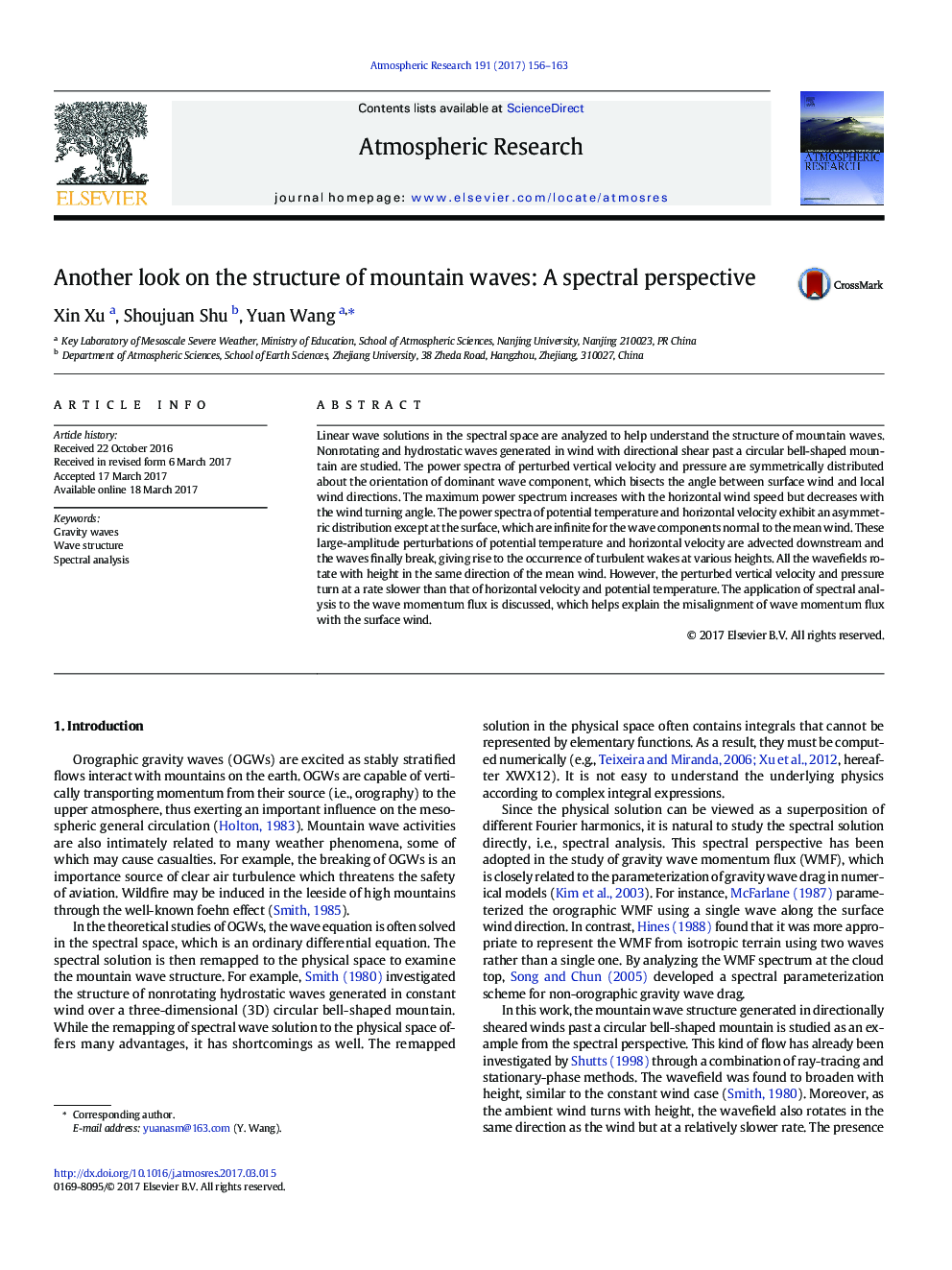| کد مقاله | کد نشریه | سال انتشار | مقاله انگلیسی | نسخه تمام متن |
|---|---|---|---|---|
| 5753805 | 1620490 | 2017 | 8 صفحه PDF | دانلود رایگان |
عنوان انگلیسی مقاله ISI
Another look on the structure of mountain waves: A spectral perspective
ترجمه فارسی عنوان
نگاه دیگر به ساختار امواج کوهی: دیدگاه طیفی
دانلود مقاله + سفارش ترجمه
دانلود مقاله ISI انگلیسی
رایگان برای ایرانیان
کلمات کلیدی
امواج گرانشی، ساختار موج، تجزیه طیفی،
ترجمه چکیده
راه حل های موج خطی در فضای طیفی برای کمک به درک ساختار امواج کوه مورد تجزیه و تحلیل قرار گرفته است. امواج ناپایدار و هیدرواستاتیک تولید شده در باد با برش جهتی گذشته از کوه دایره ای شکل به شکل کوه مورد مطالعه قرار می گیرند. طیف های قدرت از سرعت و فشار عمودی تحریک شده به طور متقارن در مورد جهت گیری مولفه موج غالب، که زاویه بین باد سطح و جهت باد محلی تقسیم می شود، توزیع شده است. حداکثر طیف توان با سرعت باد افقی افزایش می یابد اما با زاویه چرخش باد کاهش می یابد. طیف های قدرت از دما پتانسیل و سرعت افقی، توزیع نامتقارن را به جز در سطح نشان می دهند، که برای اجزای موج نامحدود برای باد معمول است. این اختلالات بزرگ دامنه دمای بالقوه و سرعت افقی را در پایین دست گرفته و موجها در نهایت شکست می خورند، که باعث بوجود آمدن آشفتگی آشفته در ارتفاع های مختلف می شود. تمام میدان های موج با ارتفاع در همان جهت باد متوسط چرخان می شوند. با این حال، سرعت عمودی و فشار عمودی تحریک می شود با نرخ پایین تر از سرعت افقی و دما پتانسیل. استفاده از تجزیه و تحلیل طیفی به شار موج شتاب مورد بحث قرار گرفته است که به توضیح عدم تقارن شار موج شار با باد سطح می پردازد.
موضوعات مرتبط
مهندسی و علوم پایه
علوم زمین و سیارات
علم هواشناسی
چکیده انگلیسی
Linear wave solutions in the spectral space are analyzed to help understand the structure of mountain waves. Nonrotating and hydrostatic waves generated in wind with directional shear past a circular bell-shaped mountain are studied. The power spectra of perturbed vertical velocity and pressure are symmetrically distributed about the orientation of dominant wave component, which bisects the angle between surface wind and local wind directions. The maximum power spectrum increases with the horizontal wind speed but decreases with the wind turning angle. The power spectra of potential temperature and horizontal velocity exhibit an asymmetric distribution except at the surface, which are infinite for the wave components normal to the mean wind. These large-amplitude perturbations of potential temperature and horizontal velocity are advected downstream and the waves finally break, giving rise to the occurrence of turbulent wakes at various heights. All the wavefields rotate with height in the same direction of the mean wind. However, the perturbed vertical velocity and pressure turn at a rate slower than that of horizontal velocity and potential temperature. The application of spectral analysis to the wave momentum flux is discussed, which helps explain the misalignment of wave momentum flux with the surface wind.
ناشر
Database: Elsevier - ScienceDirect (ساینس دایرکت)
Journal: Atmospheric Research - Volume 191, 15 July 2017, Pages 156-163
Journal: Atmospheric Research - Volume 191, 15 July 2017, Pages 156-163
نویسندگان
Xin Xu, Shoujuan Shu, Yuan Wang,
